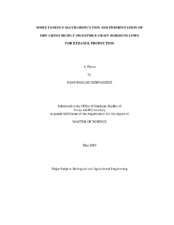| dc.creator | Hernandez, Joan R. | |
| dc.date.accessioned | 2010-07-15T00:14:00Z | |
| dc.date.accessioned | 2010-07-23T21:45:23Z | |
| dc.date.available | 2010-07-15T00:14:00Z | |
| dc.date.available | 2010-07-23T21:45:23Z | |
| dc.date.created | 2009-05 | |
| dc.date.issued | 2010-07-14 | |
| dc.date.submitted | May 2009 | |
| dc.identifier.uri | https://hdl.handle.net/1969.1/ETD-TAMU-2009-05-771 | |
| dc.description.abstract | The potential of high digestible grain sorghum (HDGS) with a modified starch protein endosperm matrix to replace corn in ethanol production was investigated using dry grind simultaneous saccharification and fermentation (SSF). Preliminary experiments showed that HDGS yielded higher amounts of glucose and ethanol than normal digestible grain sorghum (NDGS) and corn particularly in the first 48 hrs of fermentation. It was hypothesized that fast conversion of starch to glucose and ethanol during hydrolysis and fermentation are results of improved protein digestibility of HDGS.
The invagination of protein structures in HDGS produced a flourier endosperm texture, softer kernels and lower starch content than the normal digestible protein (ND) lines. Highly digestible protein (HD) lines have better pasting properties (significantly lower pasting temperature, faster rate of gelatinization and higher peak viscosity) than ND lines based on the RVA profile. Increasing protein digestibility of the HDGS improved starch digestibility (increased rate of glucose conversion and total glucose yield during saccharification), which is supported by highly significant correlation of turbidity with rate of glucose conversion and efficiency of enzymatic conversion. The efficiency of ethanol conversion is significantly correlated with starch digestibility, pasting properties, and protein digestibility. Results also showed that HD sorghum lines had significantly faster rate of conversion and shorter reaction time needed to achieve completion than ND sorghum lines and corn. Increasing the dry solid concentration from 22% to 30% (w/v) increased the ethanol yield from 8% v/v to 13%v/v. This will allow considerable saving of water, reduced distillation cost and increased ethanol production for a given plant capacity and labor cost.
Fineness of grind influences the amount of sugar formed due to variation in surface area of the flour. The hypothesis that finer particles has faster and higher glucose yield, defined as g of glucose converted per g of theoretical glucose, is supported by highly significant correlation of mass fraction of 3 to 60 mu m size range and mass median diameter (MMD) of 60 to 1000 mu m size range with glucose conversion efficiency and glucose conversion rate during saccharification and fermentation. | en |
| dc.format.mimetype | application/pdf | |
| dc.language.iso | eng | |
| dc.subject | Enzymatic hydrolysis | en |
| dc.subject | Ethanol | en |
| dc.subject | High digestible grain sorghum | en |
| dc.subject | Simultaneous saccharification and fermentation | en |
| dc.title | Simultaneous Saccharification and Fermentation of Dry-grind Highly Digestible Grain Sorghum Lines for Ethanol Production | en |
| dc.type | Book | en |
| dc.type | Thesis | en |
| thesis.degree.department | Biological and Agricultural Engineering | en |
| thesis.degree.discipline | Biological and Agricultural Engineering | en |
| thesis.degree.grantor | Texas A&M University | en |
| thesis.degree.name | Master of Science | en |
| thesis.degree.level | Masters | en |
| dc.contributor.committeeMember | Capareda, Sergio C. | |
| dc.contributor.committeeMember | Hays, Dirk B. | |
| dc.contributor.committeeMember | Karthikeyan, Raghupathy | |
| dc.contributor.committeeMember | Parnell, Jr., Calvin B. | |
| dc.contributor.committeeMember | Rooney, William L. | |
| dc.type.genre | Electronic Thesis | en |
| dc.type.material | text | en |


